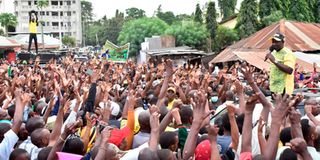Raila’s masterstrokes scattering Ruto’s numbers

Deputy President William Ruto speaks to residents in Chaani, Changamwe on June 24, 2022.
God built the universe on numbers,” said Pythagoras. As the cliché goes: “Numbers don't lie,” perhaps because they give power and rule the universe, too. This rings true of Kenya’s August 9, 2022 General Election. Victory will ride on the almighty trinity of numbers, resources and strategy – although the spiritually oriented thinkers insist on ‘the hand of God’.
Kenya’s Independent Electoral and Boundaries Commission (IEBC) has settled on four presidential candidates: former Prime Minister Raila Odinga (ODM/Azimio Coalition Political Party), Deputy President William Ruto (United Democratic Alliance-UDA/Kenya Kwanza Coalition), David Waihiga (Agano Party) and Prof George Wajackoyah (Roots Party).
But 22,120,458 registered voters will give Kenya its fifth president, who must garner at least 50 per cent plus one of the total votes cast and no less than 25 per cent of the vote in at least 24 of the 47 counties. To clinch a first-round win, President Uhuru Kenyatta’s successor needs no less than 9.1 million votes based on the 2013/2017 average voter turn-out of 82 per cent.
But who currently has the numbers? Until a month ago, crystal gazers and oracles of science alike gave the numbers to Ruto; and understandably so. Kenya’s number two hewed a campaign strategy, devoted resources and sprinted ahead long before the whistle blew.
Tide is turning
But the tide is turning. This month, the authoritative Africa Confidential journal declared that: “Now the numbers favour Raila Odinga” (Vol 63, No.2, June 9, 2022). Odinga has a 39 per cent lead against Ruto’s 35 per cent, according to a poll conducted by Trends & Insights for Africa (Tifa) on May 17. Another research firm, Info-track, extends Odinga’s lead to 42 per cent against Ruto’s 38 per cent.
The game-changer is the battle for the running mates, which Odinga won and Ruto seemingly lost. Odinga’s numbers shot meteorically soon after naming former Justice Minister and Narc-Kenya leader Martha Karua as his running mate. On the flipside, Ruto’s numbers tipped after he announced the current MP for Mathira, Rigathi Gachagua, as his running mate.
Besides changing the fortunes of the candidates, the running-mate question has also impacted on their respective strategies. Ruto’s game plan has been to retain intact the ‘tyranny of numbers’ hoisted on Kikuyu-Kalenjin détente that enabled him and Kenyatta to win and retain power over the past decade. But this is morphing into a risky gamble. In 2013, Kenyatta scraped through the 50-per-cent-plus-one mark with only 8,000 votes! It would be a tall order for Ruto to achieve the same feat. The big mobilising factor in 2013 was the International Criminal Court (ICC), which is now absent. In Mt Kenya, Kenyatta and Odinga have ceased to be the boogeymen for vote mobilisation. And the ideological grip of the ‘hustler versus dynasty’ narrative has wilted in the heat of campaigns.
Ruto’s strategists failed to diligently scan all the horizons. Perhaps Gachagua, a mobiliser and bare-knuckled fighter, is what Ruto needed to neutralise Kenyatta’s long-awaited blitz to dislodge Ruto and win back Mt Kenya for Azimio. But with Kenyatta’s last-minute decision to stay away from electioneering, a ‘gladiator’ as a running mate is a heavy millstone around Ruto’s neck.
Raila’s strongholds
Ruto’s manifestly powerful juggernaut is yet to gain the necessary numbers in Odinga’s strongholds in Nyanza, Ukambani, Western and the Coast to significantly tilt the race in his favour. And Gideon Moi and the Kanu are nibbling into Ruto’s sphere of influence in the turf war for the leadership of Kalenjin Rift Valley.
Odinga has hewed a two-pronged strategy to achieve a first-round win. An all-hands-on-deck approach has enabled him to maintain much of the 44.94 per cent he won in his strongholds in August 2017. He personally led the massive voter registration in Nyanza and parts of Western Kenya. Intense campaigns have enabled him to retain his lead in the Maa-speaking counties (Samburu, Narok and Kajiado), Turkana and the Coast.
Second, Odinga has invested heavily in the battle for the soul of Mt Kenya, which does not have one of its scions as a strong presidential candidate. With 5.3 million voters in 2017, and estimated at 7.3 million voters today, ‘the Mt Kenya bride’ is worth the prize.
Odinga’s masterstroke was naming Karua as his running mate, a classic buy-one-get-three deal: An untainted and courageous leader to spearhead his national campaign against corruption; a veteran leader and respected daughter of Mt Kenya to help him ‘climb the mountain’; and an experienced and credible women leader to win over the female vote.
However, delivering at least 60 per cent of the Mt Kenya bloc to Azimio is key to Karua’s own political future. Over the past month, she has extended Azimio’s lead in the Mountain region by more than 10 per cent.
An intense behind-the-curtain diplomacy after the naming of Karua as running mate succeeded in bringing Kalonzo Musyoka back into the Azimio house, which would have lost more than 85 per cent of the vote Odinga got in Ukambani in 2017 and perhaps push the election to a run-off.
The big question, however, remains whether the numbers of Kenya’s young people will tilt the scales, possibly triggering a run-off. In its recently unveiled final voters’ register, IEBC revealed that elderly voters are more than the youth. Only 8.8 million 18-35 year olds are registered as voters against 13.3 million of the elderly. This tilts the numbers in favour of Azimio, which has the support of elderly voters.
Prof Kagwanja is CEO of the Africa Institute and former government adviser.





